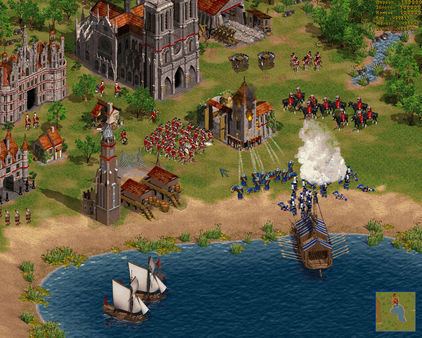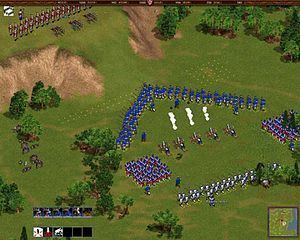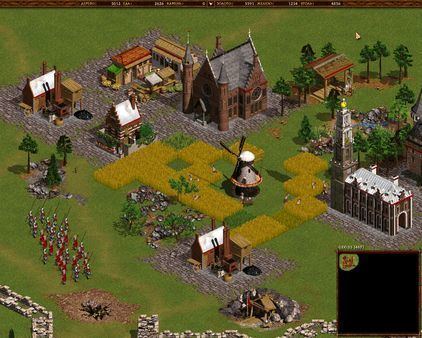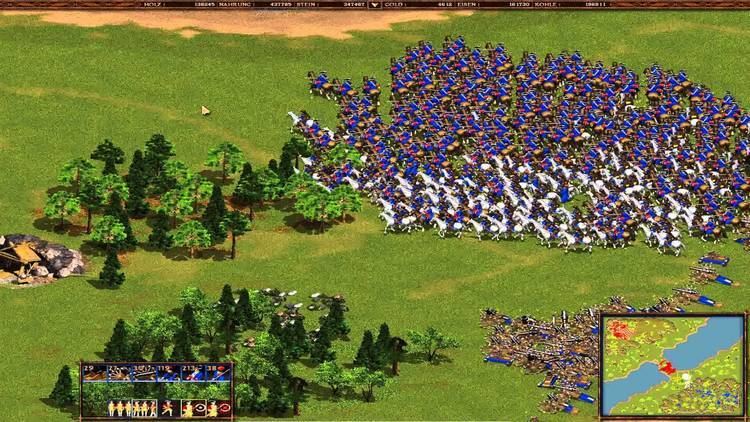7.2 /10 1 Votes7.2
7.5/10 IGN Release date(s) EU: 30 November 2000 | 7/10 Steam 74% Metacritic Initial release date 30 November 2000 Genre Real-time strategy | |||||||||||||||||||||||||||||||||
 | ||||||||||||||||||||||||||||||||||
Similar Cossacks games, GSC Game World games, Real-time strategy games | ||||||||||||||||||||||||||||||||||
Cossacks: European Wars is a real-time strategy video game for Microsoft Windows made by the Ukrainian developer GSC Game World. It was released on 24 April 2001. The game has an isometric view and is set in the 17th and 18th centuries of Europe. It features sixteen playable nations each with its own architectural styles, technologies and units.
Contents
- Gameplay
- Maps
- Nations
- Development
- Cossacks The Art of War
- Cossacks Back to War
- Cossacks Campaign Expansion
- Reception
- Related games
- References

Players must avoid famine and engage in army expansion, building construction and simple resource gathering. Mission scenarios range from conflicts such as Thirty Years' War to the War of the Austrian Succession, and the game is renowned for the seemingly unlimited number of units players may control. This ability set it apart from other games of the time such as Age of Empires and Empire Earth.

Cossacks is a game which allows the user to gain strategy skills and even pick up some relative history of that period by the inclusion of a comprehensive encyclopedia. This top selling title has won two awards and was positively favoured by a majority of reviewers.

Gameplay

There are 6 basic resources in the game that are crucial to the player's military victory. These are gold, wood, food, stone, iron and coal. Gold, iron and coal may only be acquired by constructing mines over a designated resource area and sending peasants into them whereas food is cultivated from mills and via the use of fishing boats. Wood and stone are gathered by conventional means and there are also specific areas where these may be collected. Depending on the type of unit or structure being built, the amount of resources needed to create a unit/structure would inflate quantitatively with each successive one built or trained. Depleted resources would result in an undesirable penalty for the player such as a lack of food will signify a famine for the state and the player's units will die from lack of supplies. Similarly, a lack of coal and iron means that shooters and cannons will cease to fire their weapons whereas a lack of gold will mean that units which require maintenance paid will commit mutiny against the state. The economic workforce consists of peasants who can multitask and also attack enemy soldiers. They can, however, also be captured by enemy troops and turned to the enemy's allegiance.

Cossacks depart from common RTS titles in that military actions may be conducted by assigning formations to soldiers or allowing them to attack solitarily without proper formations. Formations may be made by grouping exactly 15, 36, 72, 120 or 196 of a single unit type in the presence of a corresponding officer and drummer. 3 different types of formations may be assumed and used for different attacking methods.

Units in formations may also be issued a 'stand ground' order where they would also be granted a defensive bonus as well as a morale improvement. Cavalry units may also be grouped into formations and function in a similar manner as would an infantry formation minus the officer and drummer units. Upgrades which affect weaponry and defensive stats can be researched in the barracks or the stables or the armories. An academy or a minaret (for various scientific research) is also needed to train officers and to build formations. There are various strategies of controlling an army developed by players during the continuous gaming online.
Artillery in the game are divided into mortars, cannons, multi-barrelled cannons and howitzers and all have distinct functions which are suitable in one situation but may not be appropriate in the next. Mortars are primarily used to bombard enemy buildings and ships from afar. The resulting shrapnel and debris upon impact on the building(s) would also kill nearby enemy units as well as the player's own if in the vicinity. Cannons are the staple of the artillery forces in Cossacks and possess good range (which can be improved with its corresponding research) and shot power but are not particularly powerful against buildings, especially after the buildings' upgrades have been researched. Cannons are also able to fire a grape shot to eradicate a cluster of enemies at short range whereas a multi-barrelled cannon (must be researched at the academy and is not available to all nations) also functions in a similar manner but reloads quicker than the cannon. Howitzers are the shortest ranged artillery but possess the best shot power. They fire in an arc which means that enemy walls will not block their ordnance. They are good against both soldiers and buildings but should be escorted by guards. All artillery units may be captured by enemy forces in the same manner as the peasant workforce. The main upgrades for artillery are the extended range, the accuracy and its build time and cost.
The player may also construct ships to wage naval battles and may build from a choice of yacht, galley, frigate or an 18th-century battleship. Nations which are historically not well-developed are restricted in the building hierarchy to just galleys. Turkey may build xebecs which are technologically equivalent to the Western powers' frigates. Ships are used for naval domination or for shore bombardment. A player may also build ferry units to prepare for a naval assault over large bodies of water. Larger ships typically require gold for upkeep and its crew would mutiny against the owner if the resource has been depleted.
Shooters (such as the musketeer and the strelets units) take time to reload their weapons after a volley and are vulnerable to a melee counter-attack. Ranged units also require a fair distance to be able to shoot at targets and will often retreat backwards to acquire the required distance. Different shooters possess different ranges while shooting and mounted dragoons do more damage than the regulars. Significant upgrades can be conducted to raise the level of damage possible and certain upgrades can also be purchased to halve the cost of producing shooters.
Grenadier units can destroy buildings with their grenades as well as engage enemies in both melee and ranged attacks. Military production buildings (e.g. barracks and stables) may only be destroyed by artillery and/or grenadier units whereas civilian buildings may be captured as per the usual means.
Maps
In Cossacks there is a multitude of playable, randomly generated maps in addition to five long campaigns which are considered extremely difficult to beat. These campaigns are historically accurate, and often pit the player against impossible odds.
Nations
Development
Cossacks:European Wars was developed in Ukraine by GSC Game World. The game has been noted for artistic qualities and great graphics, in particular the special effects which were once described as "second to none". Another remarkable feat, is the technology tree having more than 300 upgrades.
Desires to create the game Cossacks began in 1997, when Age of Empires was published, and development started in 1998. The 17th and 18th centuries were selected because the most obvious continuation of Age of Empires would be medieval Europe and Cossacks was its logical successor, not a competitor. At first, Cossacks was supposed to be about the confrontation in Ukraine and Russia and there would be four nations: Ukraine, Russia, Europe and Turkey. The game would be sold in the domestic market. After the exhibition MILIA in Cannes, where a demo version of Cossacks had received good reviews from reputable people associated with the creation and publishing house of computer games, it was decided to increase the number of nations to 16 and sell the game around the world. In order to be able to play on the map with thousands of units, 2D graphics were selected.
The number of people who developed the game was increased from four in 1998 to twelve in 2000, when the project was nearing completion. At different stages of the work, authors of maps and testers joined the development. In March 2001, Cossacks: European Wars appeared in stores.
The game was re-released in 2011 on the Steam platform, along with its sequel Cossacks II. The games are also available DRM-free from GOG.com.
Cossacks: The Art of War
The Art of War, released on 1 April 2002, is the first standalone expansion pack. Like the original Cossacks, the game is set in the 17th and 18th centuries, and 8000 units can be controlled. Cossacks: The Art of War adds 5 new campaigns, 2 new nations (namely Denmark and Bavaria), a map editor, and 16 times larger maps with new terrains. Both new nations possess an 18th-century Musketeer unit, which have different attributes.
Cossacks: Back to War
Back to War, released on 18 October 2002, is the second expansion pack, and it can be played as a standalone. Cossacks: Back to War adds two new nations (Switzerland and Hungary) to the choices from Cossacks: European Wars and Cossacks: Art of War because of their influence on European history. There are also new maps, a tutorial campaign and a map-editor. It adds several units to various countries, new cannon types and alters some parameters such as building time, upgrade and building costs.
Cossacks: Campaign Expansion
Cossacks: Campaign Expansion, released on 1 November 2002, is a piece of downloadable content for Cossacks: Back to War. It contains four single-player campaigns from the original game, Cossacks: European Wars, and five from The Art of War: nine campaigns with 63 hardcore missions.
Reception
Reviews for Cossacks: European Wars range from fair to good. Cossacks: European Wars received a PC Zone award for excellence and the Strategy Player Game of the Month award.
Reviewers generally praised the detail and accuracy during gameplay and felt the cut scenes and opening video were impressive. A GameSpot review noted how the game followed the traditional formula of the RTS genre, exhibiting significant similarities to Age of Empires II: The Age of Kings but that the diverse types of factions and military units added to the playability. Another conclusion was that some of the larger scenarios can be quite daunting due to having to manage many resources and a large fighting force. A review in ESC Magazine described it as a complex game with lots of mouse clicks and fast artificial intelligence for computer opponents.
A review by IGN staff concluded that the game's depth, potential and lasting appeal were its strong points but poor design decisions detracted from its playability. They also thought the artificial intelligence was below par, as the variable defensive abilities of their forces resulted in significant imbalances. The PC Zone review described the game's graphics as detailed and impressive, and liked the historical accuracy, smooth unit movement and 3D landscapes.
Related games
The official game sequel is Cossacks II: Napoleonic Wars. There is a spin-off of Cossacks from GSC Game World using the same engine, American Conquest series. GSC Game World created Alexander, a less successful strategy game for the pc. Also to be noted is the RTS-RPG, Sci-fi Fantasy crossover Heroes of Annihilated Empires released in 2006: which owing to poor AI became a less successful project.
